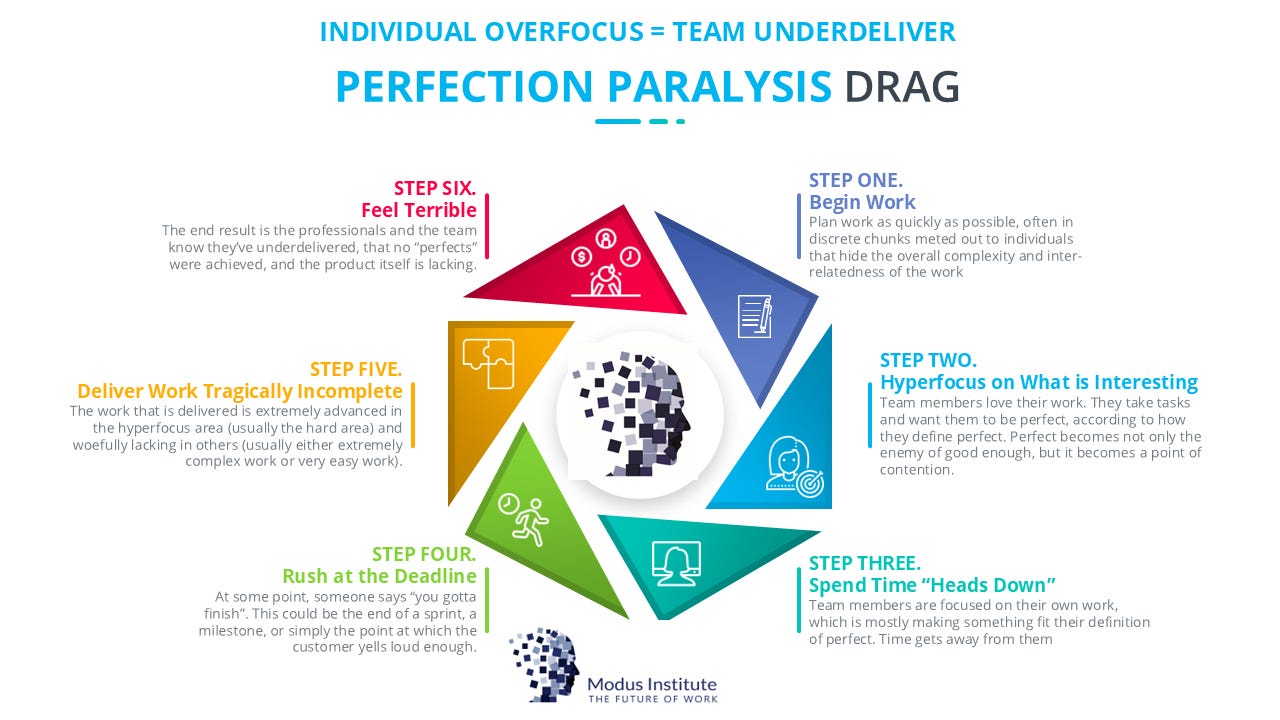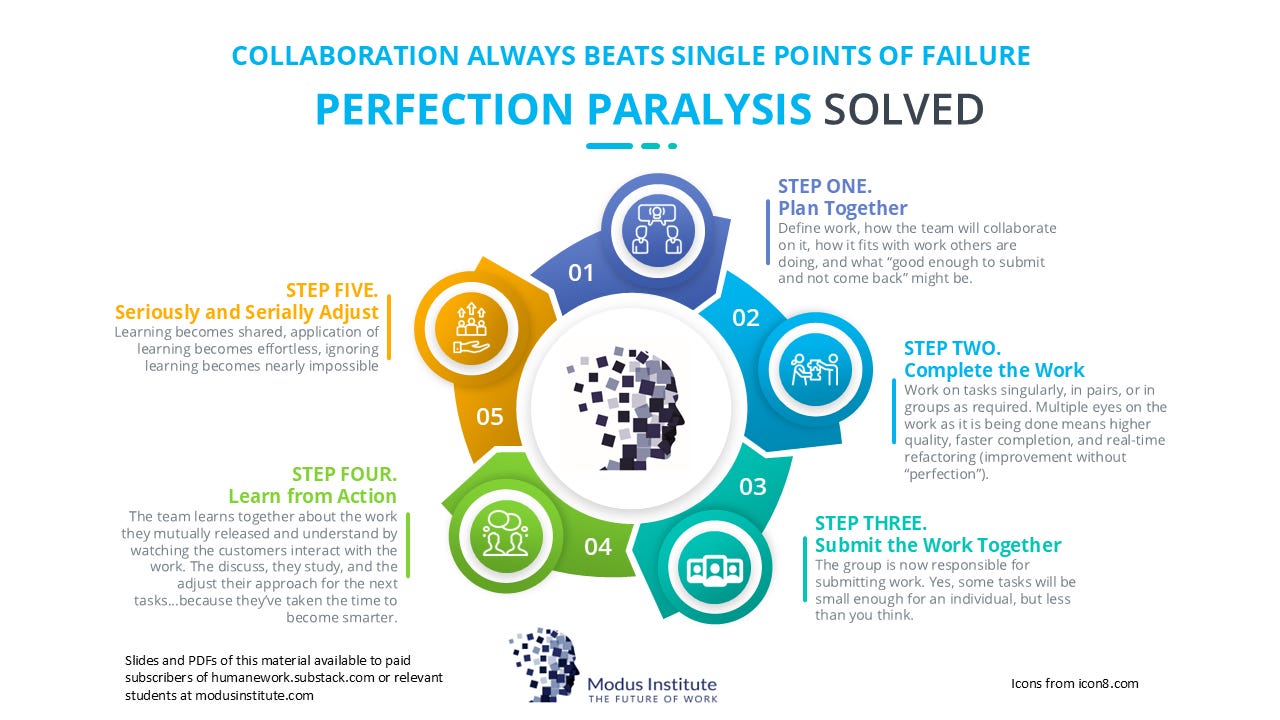Perfection Paralysis – Drag & Flow 02
Working with Neurodiversity Visually

You will often hear the dismissive “Perfect is the enemy of good enough” from people who won’t take the time do define what good enough is.
Every team wants to do great work. But "great" becomes a moving target and "perfect" becomes the enemy of "done". But the notion of “Perfect” is a huge part of neurodiversity.
Perfectionism is central to human achievement and every office culture grapples with it. We have different spins that result in disparate notions of "excellence." Excellence becomes a regimen, the regimen becomes bureaucracy.
Or…the opposite. We convince ourselves that we are all super creative and amazing and soon the team is doing work in 15 different ways, each chasing their own notions of completeness and perfection.
For the bureaucratic, we will invent review processes, adopt new tooling, create revision cycles, invent ritualized meetings and other theater to protect quality. As we do, we become even more paralyzed and our perfectionist status rises, we start to find ways to work around the system to seek our individual perfection because we were so busy figuring out how to tool for perfection, we never asked ourselves what good product really looked like.
The Definitions of Perfection Paralysis
As with the first article in this series, I have a story about Perfectionism Paralysis Drag, but first…a few definitions.
Perfectionism Paralysis Definition: The pursuit of personally defined perfect outcomes prevents completion and delivery of work, sometimes driven by fear of criticism or failure, sometimes by the process we’ve created, and sometimes by the ways individuals focus their attention. This creates both cognitive overload, work slow-downs, and systemic dysfunction while generating weird one-off bottlenecks.
How Perfectionism Creates WIP: Work gets stuck in endless revision and polishing, often at one person’s desk. That person is focused on finishing their task, which is falling out of alignment with their colleagues, created additional work to discover issues and correct for them later. The fear of "not good enough" creates additional research, review, and validation work. Meanwhile, other work accumulates waiting for the "perfect" solution that never comes.
How it is Toxic: Perfectionism is actually powerful, but unharnessed, that power creates anxiety and burnout, establishes unrealistic standards that demoralize teams, and often results in delayed or cancelled projects despite significant investment. It breeds resentment from the individual perfectionist, team members who feel nothing they do is ever good enough, and the people waiting for the work to be done.
A Quick Story of Solving Perfection Paralysis
A large insurance company in Seattle had teams working incredibly hard to create products (digital and physical). They had a very neurodiverse team. Everyone learned, defined their own value, and hyperfocused in different ways. Some focusing on perfecting small parts of single tasks, others trying to perfect the entire project at once. Both approaches left work perpetually undone as "perfection" was never achieved.
I want to be extremely clear here. Everyone on the team was talented, knowledgeable, smart, and driven. They were a joy to work with, they liked each other. And they were frustrated. They knew they could do better.
Their work always ended up rushed at deadline-time and it always lacking in some key ways. Rework was inevitable. This really upset the team members, but they were fighting two battles.
The company / management had no definitions for an acceptable outcome, so even though the tasks were defined, quality delivery was not.
The varying types of neurodiversity meant perfectionism loops were focused on the hardest thing in a particular task or making everything absolutely perfect (so the team itself wasn’t able to define an acceptable delivery).
At the beginning, the daily work was this:
Start work → Hyperfocus on making it perfect → Never finish because it's not perfect enough → Rush at deadline → Deliver something incomplete → Feel terrible about quality → Repeat
It was so painful.
We laid their work out with a Value Stream Mapping exercise. During that exercise, it became clear to the team that this dynamic was killing them. Two people that worked with each other every day, were friends, and had been growing frustrated with each other stood staring at a part of the Value Stream that showed a “fail point”…where the end-goal of work should have been defined, but wasn’t.
They realized some key things about how they worked.
1. The team should have multiple work definition sessions for work that impacted other people or was complex in some way
2. Those two people could say the same thing about “done”, but have very different meanings of the complete and ways to get there.
3. That with their Personal Kanban, “Done” didn’t mean perfect, it meant works fine for the customer and will continue to.
4. The only way to avoid individual perfection loops was to work together on tasks. In pairs or in larger groups depending on the complexity of the task. “Pairing” or “Mobbing” would keep them focused on the deliverable, work quickly together on smoothing the “imperfect”, and as a group maintain focus on completion over perfection.
They replaced their stilted, individual workflow with:
Start work → Define "good enough to submit and not come back" as a group → Complete work together as much as possible → Submit → Learn from feedback → Apply learning to next work → Repeat with increasing confidence
The perfectionists were important because they cared deeply about quality. The more they tried to make everything "perfect," the more they exacerbated the problems. Before the change, they created work that was either incomplete or over-engineered, spun on tasks without communicating, set standards no one could meet, and "improved" things in ways that made them less useful every time.
This is covered, in detail and with design patterns, in The Collaboration Equation book and is a centerpiece of our Distributed Teams and Visual Management classes.
Their new system solved this problem by:
Creating and using a Personal Kanban for the team that defined "done" as "good enough to enter the DONE column and not come back". Meeting client needs at a high enough level of quality to be accepted and even enjoyed, but not requiring "COMPLETE PERFECTION."
Using the perfectionist's care for quality as an advantage
Making sure the definition of done was visual, explicit, and collaboratively agreed upon
Ensuring that work could be completed and delivered collaboratively to set helpful high standards (focused on quality delivery, not just amazing individual technique)
Creating a permission engine to let go and move forward (when the work was agreed to be in a “good enough” state, that was the true definition of “perfect”.)
Created a system that was productive, sustainable, and fully understood by the team.
Ultimately this allowed the “perfectionists” to redefine perfect in a way that was shared by all. The team could stop working as manic silos and begin to work as a team, enjoying each other’s expertise, and, over time, able to understand how they worked and constantly improve their delivery and the product.
In this case, different styles of hyperfocusing were like different hex wrenches. If you find the right one at the right time, the work becomes much easier.
When working collaboratively, the team itself not only understood its work better, it understood its people better. In the Collaboration Equation, I say that Individuals in Teams Create Value. When we treat people as fungible or easily swapped, we treat them like a generic “hex wrench” but we don’t fully get that they have a certain nuance that solves problems, completes work, or brings a creative spark during problem solving.
The Dash of Added Context
At the end of these posts, I’m just going to talk about the visualizations and what they mean to me. We have worked with so many teams who have worked so hard to understand their own work, to find their individual way of working (optimization, if you wish), and what they manage to overcome is nothing short of astonishing.
I simply have not seen a team develop visualizations for their team’s work that doesn’t have hooks for the personalities of the group, alone or together. Everything from maps of hamburger places, to Vanilla Ice quotes, to rapid upskilling. In this case, they went straight for solving the disconnects of neurodiversity, without labels, blame, or stigma. Simply by knowing who they were, what each person could bring to the table, and wanting to make the absolute most of it.
Lessons to Appreciate
Flexible Predictability: The perfectionists identified with high quality and careful work. They really enjoyed what they did. The board and the new way of working let them set quality standards in real-time without undermining anyone’s values, learning styles, or previous contributions. We didn’t want to demoralize quality-focused professionals before the problem is solved. To respond to that specifically, all work still has quality standards, but they're defined by the team as a group and achievable rather than vague or assumed.
Clarity During Anxiety: The board was clear and functional, with shared criteria for "done" that everyone could see and work with. This counteracted the "never good enough" anxiety.
Obviously Collaborative: The board was built together, could be modified by the team, and the overall victory condition for everyone was to deliver great work that satisfied clients and didn't need to come back for fixes. Don't let individual anxiety drive team paralysis. This group loved numbers and metrics. Once work actually started to flow, they were quick to mark progress and improve.
DONE is not "Perfect" but Good Enough to Not Come Back" is: The DONE column focuses on client needs and long-term reliability, not individual perfection. The "definition of done" is that the work meets its purpose and won't generate rework, not that it's flawless.
CALL TO ACTION:
If this is interesting to you, you can hire me and Toni to help (just message me on substack or LinkedIn), or take a class at Modus Institute, or simply get a paid subscription to Humane Work here on substack (button above).
This is what we do and have done for decades, and what we work with others on. Simple, visual, humane strategies to fix the real problems of work.



